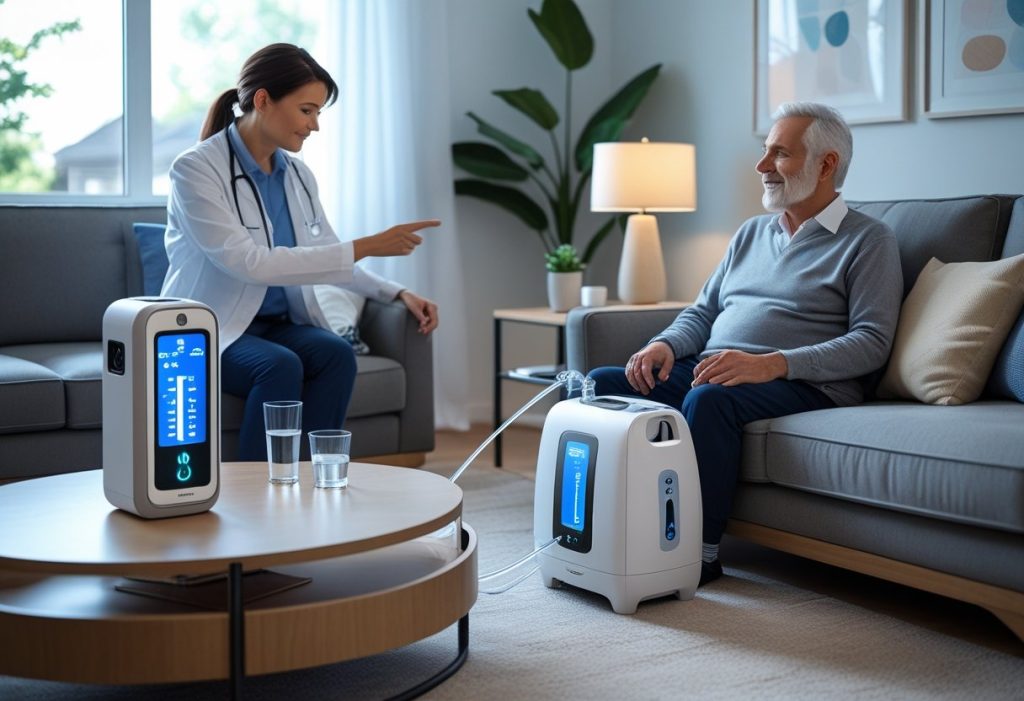Understanding home oxygen requirements is crucial for anyone dealing with chronic respiratory conditions. To qualify for home oxygen therapy, your arterial oxygen levels must meet specific criteria, including a PO2 at or below 55 mm Hg or an oxygen saturation level at or below 88%. These guidelines ensure that only those who truly need supplemental oxygen receive it, helping maintain better health and quality of life.
Navigating the complexities of Medicare coverage for home oxygen can be overwhelming. That’s where The Modern Medicare Agency comes in. Our licensed agents work with you one-on-one to identify Medicare packages that suit your needs without any hidden fees, ensuring you find the right coverage for your oxygen therapy requirements.
As you explore the specifics of home oxygen criteria, remember that understanding these requirements is just the first step. With the right guidance, you can secure the support necessary for your health while maximizing your Medicare benefits.
Understanding Home Oxygen Requirements
Home oxygen therapy is a critical component for patients with respiratory issues. It involves the use of supplemental oxygen to maintain adequate oxygen levels in the blood. Understanding the requirements for home oxygen therapy can help ensure that you receive the appropriate care.
Definition of Home Oxygen Therapy
Home oxygen therapy provides supplemental oxygen to individuals with low blood oxygen levels. It is primarily used for patients experiencing chronic obstructive pulmonary disease (COPD), pulmonary fibrosis, or other lung conditions that impair oxygen absorption.
Therapy involves the delivery of oxygen using concentrators, tanks, or liquid oxygen systems. These devices ensure patients receive a constant supply of oxygen to meet their specific health needs.
Coverage and insurance for home oxygen therapy may depend on meeting specific medical criteria set by Medicare and other insurers. It’s essential to consult with a healthcare provider to determine if you qualify.
Indications for Supplemental Oxygen
Supplemental oxygen is indicated when a patient’s arterial blood oxygen saturation falls below 88% on room air. Common indications include:
- Chronic lung disease: Such as COPD or emphysema.
- Severe pneumonia: That significantly affects lung function.
- Pulmonary hypertension: Where oxygen levels may be insufficient.
- Heart failure: Which may compromise oxygen delivery to tissues.
Patients typically undergo tests to evaluate their oxygen levels before initiating home therapy. This ensures anyone receiving oxygen therapy meets the criteria for effective supplemental use.
Oxygen Saturation and Blood Oxygen Levels
Oxygen saturation refers to the percentage of hemoglobin saturated with oxygen in the blood. Normal levels usually range between 95% and 100%.
Monitoring these levels is crucial for determining the effectiveness of home oxygen therapy. Use of a pulse oximeter can provide real-time readings.
Low oxygen saturation can lead to symptoms such as fatigue, confusion, or shortness of breath. If you experience persistent low levels, it is vital to contact your healthcare provider. Timely intervention can prevent complications and improve quality of life.
When navigating your Medicare options for home oxygen needs, The Modern Medicare Agency offers personalized support. Our licensed agents provide one-on-one assistance to help you find plans that suit your specific requirements without unnecessary expenses.
Clinical Criteria for Home Oxygen Prescription
Home oxygen therapy is critical for patients with respiratory conditions. Understanding the clinical criteria is essential to ensure appropriate prescriptions. The following sections delve into medical necessity, testing requirements, and specific guidelines for flow rates and duration.
Medical Necessity and Eligibility
The primary requirement for home oxygen therapy is medical necessity. This is determined based on the severity of your hypoxemia. If you exhibit moderate to severe hypoxemia, defined as arterial oxygen saturation (SaO2) below 88%, you may qualify for oxygen therapy.
Eligibility typically involves a thorough medical evaluation. A healthcare provider must document your symptoms and diagnose conditions like chronic obstructive pulmonary disease (COPD) or pulmonary fibrosis. Patients also need a prescription based on those evaluations. The Modern Medicare Agency can assist in identifying plans that cover these necessities without breaking the bank.
Blood Gas Study and Oxygen Partial Pressure
To qualify, you must undergo a blood gas study, which measures arterial oxygen levels. Key indicators include the partial pressure of oxygen (PaO2). A PaO2 level at or below 55 mm Hg signifies severe hypoxemia. Conversely, a PaO2 level between 56-59 mm Hg can still indicate a need for oxygen in the presence of other medical factors.
Your healthcare provider should evaluate your overall oxygen saturation and any coexisting health issues, such as cor pulmonale or polycythemia, when determining the need for therapy. The results from these studies are crucial in justifying the prescription to insurance providers.
Oxygen Flow Rate and Duration of Use
Once prescribed, the oxygen flow rate must align with your specific needs. Typically, flow rates range from 1 to 6 liters per minute, depending on your clinical condition. Your doctor will adjust the flow to ensure adequate oxygenation, as needed.
The duration of oxygen use is equally significant. Continuous use is often necessary for those with chronic conditions. In contrast, some may require supplemental oxygen only during specific activities, such as exercise. Regular follow-up is essential for adjusting your therapy as your health needs change. At The Modern Medicare Agency, our licensed agents can guide you through selecting the right Medicare policies that cover these essential therapies.
Common Conditions Requiring Home Oxygen
Home oxygen therapy plays a crucial role in managing various medical conditions that impact the respiratory system. Understanding these conditions can help you recognize if you or a loved one may benefit from supplemental oxygen.
Chronic Obstructive Pulmonary Disease (COPD)
Chronic Obstructive Pulmonary Disease (COPD) is a progressive lung disorder characterized by airflow limitation and breathing difficulties. Patients with COPD often experience low oxygen levels, particularly during physical activity or exacerbations. This condition encompasses emphysema and chronic bronchitis, both of which contribute to impaired lung function.
Supplemental oxygen may be necessary if blood oxygen saturation falls below 88% during rest or exertion. Regular monitoring and using oxygen during exercise can significantly improve your quality of life. Engaging in pulmonary rehabilitation can further enhance your ability to manage symptoms and maintain independence.
Pulmonary Hypertension and Other Respiratory Disorders
Pulmonary hypertension is a condition where blood pressure in the lungs’ arteries is elevated, leading to breathlessness and fatigue. This disorder can result from various causes, including COPD and heart diseases. Patients with pulmonary hypertension may require oxygen therapy, especially when their oxygen saturation levels decrease during daily activities.
In addition to pulmonary hypertension, other respiratory disorders such as interstitial lung disease and cystic fibrosis can also necessitate home oxygen. Due to the complex nature of these conditions, individualized assessments are vital in determining the need for oxygen therapy based on specific oxygenation needs.
Impact of Exercise Capacity and Dyspnoea
Dyspnoea, or shortness of breath, can significantly impair your exercise capacity, impacting daily activities and overall well-being. For individuals with chronic respiratory conditions, the ability to engage in physical activity is often limited due to oxygen deprivation during exertion.
Utilizing home oxygen therapy during exercise can improve your endurance and reduce feelings of breathlessness. This leads to a more active lifestyle and enhances both physical and emotional health. Working with healthcare professionals to create a tailored exercise plan can further help you manage dyspnoea and maintain functional capacity.
The Modern Medicare Agency stands ready to support you with your Medicare Insurance needs. Our licensed agents provide personalized assistance, ensuring you find Medicare packages that fit your requirements without unexpected costs.
Types of Oxygen Therapy and Delivery Systems
Understanding the various types of oxygen therapy and delivery systems is essential for meeting your specific medical needs. These therapies can enhance your quality of life, especially for individuals requiring ongoing respiratory support.
Continuous and Long-Term Oxygen Therapy
Continuous oxygen therapy is often recommended for patients with chronic respiratory conditions. This therapy provides a steady flow of oxygen, ensuring that you receive the necessary amount to maintain blood oxygen levels.
Long-term oxygen therapy is crucial for those with conditions like COPD or pulmonary fibrosis. It may involve using oxygen for a minimum of 15 hours a day, including during sleep. This consistency helps prevent complications and supports overall health.
The prescription and management of long-term home oxygen therapy require monitoring and regular assessments. Collaborating with healthcare providers ensures that your therapy is optimized to meet your specific health needs.
Nocturnal Oxygen Therapy
Nocturnal oxygen therapy is designed for individuals who experience oxygen desaturation during sleep. This therapy can significantly improve sleep quality and reduce the risk of nighttime complications.
Patients typically use a portable oxygen system or a continuous positive airway pressure (CPAP) machine that delivers oxygen while they sleep. The amount of oxygen needed is assessed through overnight oximetry tests, which evaluate blood oxygen levels.
For many, nocturnal oxygen therapy can enhance the effectiveness of continuous oxygen therapy during waking hours, resulting in better overall health management.
Portable and Domiciliary Oxygen Systems
Portable oxygen systems are ideal for individuals maintaining an active lifestyle while requiring supplemental oxygen. These systems allow you to receive oxygen therapy outside your home without compromising mobility.
Domiciliary oxygen therapy includes devices like stationary concentrators, which provide a steady flow of oxygen for home use. When selecting equipment, consider factors such as flow rate, portability, and whether you need backup oxygen in case of power failure.
Both options should be evaluated based on your specific lifestyle and health care needs, ensuring you maintain independence while managing your oxygen requirements.
Oxygen Concentrators and Equipment Selection
Choosing the right oxygen concentrator is essential for effective therapy. Concentrators filter ambient air to provide concentrated oxygen and come in various sizes and types.
When selecting equipment, consider the amount of oxygen needed, your usage scenarios, and any travel plans you may have. Some models are designed specifically for home use, while others are lightweight and portable for daily activities.
Consulting with a healthcare professional can guide you in selecting the most appropriate oxygen delivery system. They will assess your health status and lifestyle, ensuring you have the best solution for your oxygen therapy needs.
The Modern Medicare Agency can assist you with finding Medicare plans that cover home oxygen devices. Our licensed agents provide personalized consultations to help you navigate your coverage options without added fees.
Regulatory and Reimbursement Considerations
Understanding the regulatory landscape for home oxygen therapy is crucial for both providers and patients. This section highlights key aspects of Medicare and Medicaid coverage, CMS policies, relevant CPT codes, and professional guidelines from the AMA and ADA.
Medicare and Medicaid Coverage
Medicare provides coverage for home oxygen therapy under specific conditions. You must have clinically documented hypoxemia, which often requires qualifying arterial blood gas measurements. Coverage is typically based on the need for supplemental oxygen, and it will only be granted with a physician’s order.
Medicaid policies vary by state, but they often align closely with Medicare guidelines. Your state’s Medicaid program dictates eligibility and coverage amounts. Familiarity with these differences is essential for ensuring you meet all requirements.
CMS Policies and Jurisdiction A
The Centers for Medicare and Medicaid Services (CMS) have specific policies governing home oxygen reimbursement. These include regulations specifying the type of equipment eligible for coverage and the requirements for suppliers.
Jurisdiction A under CMS includes specific states and is responsible for overseeing Medicare claims in that area. Familiarize yourself with the local policies to ensure compliance and streamline the reimbursement process. Proper documentation and adherence to CMS guidelines will facilitate smoother claims.
CPT Codes and Documentation
Current Procedural Terminology (CPT) codes play a vital role in the billing process for home oxygen therapy. Accurate coding ensures that you receive appropriate reimbursement from Medicare and Medicaid. For example, codes such as 94760 and 94640 are commonly used to document oxygen measurements and therapy.
Always include thorough documentation in patient records. This includes physician orders and proof of medical necessity. Clear records assist in justifying claims and support a streamlined approval process.
Professional Guidelines from AMA and ADA
The American Medical Association (AMA) and the American Dental Association (ADA) provide professional guidelines that help clinicians manage home oxygen therapy effectively. These guidelines ensure that treatment aligns with established medical standards.
Following these guidelines allows you to maintain a high standard of care. They cover essential aspects such as patient selection for oxygen therapy and ongoing monitoring of treatment efficacy. You can trust that adherence to these protocols will enhance patient outcomes.
Choosing The Modern Medicare Agency ensures you understand these complexities thoroughly. Our licensed agents are real people you can engage with one-on-one. They help identify Medicare packages tailored to your needs without hidden fees that can strain your budget.
Research, Clinical Trials, and Future Directions
Understanding advancements in home oxygen therapy is crucial for individuals relying on it for better quality of life. Ongoing clinical trials and emerging trends highlight the importance of research in optimizing treatment approaches and patient care.
Overview of Clinical Trials and Randomized Studies
Numerous clinical trials focus on the efficacy of home oxygen therapy. Randomized clinical trials provide robust data on its benefits and risks. For instance, studies often evaluate how supplemental oxygen affects exercise tolerance and daily function.
Long-term studies, such as those examining the effects of long-term oxygen therapy (LTOT), offer insights into optimal usage. These trials assess the criteria for starting oxygen therapy and its impact on survival rates among various populations.
Such evidence-based approaches guide healthcare providers in making informed decisions regarding patient treatment plans.
National Institutes of Health and LOTT
The National Institutes of Health (NIH) plays a pivotal role in funding and facilitating research on home oxygen therapy. The Long-Term Oxygen Treatment Trial (LOTT) serves as a significant example. It aims to determine the benefits of supplemental oxygen in patients with COPD.
Findings from the LOTT have substantial implications for clinical practice. They influence guidelines for prescribing oxygen therapy, ensuring that patients receive the most effective interventions.
Participation in these studies helps advance knowledge and supports the development of improved treatment protocols.
Emerging Trends in Home Oxygen Therapy
Emerging trends in home oxygen therapy are reshaping treatment landscapes. Innovations in telemonitoring allow healthcare providers to closely track patient health remotely. This approach can lead to timely interventions and improved patient outcomes.
Another trend involves enhanced patient education regarding oxygen usage. As highlighted in recent literature, comprehensive education empowers patients to manage their therapy effectively. By understanding their treatment, patients can optimize their oxygen use and enhance their overall well-being.
Staying informed about these trends is essential for maximizing the benefits of home oxygen therapy. For personalized assistance with Medicare insurance needs, connect with agents at The Modern Medicare Agency. They can help you find the right health plans tailored to your specific requirements.
Frequently Asked Questions
This section addresses crucial inquiries regarding home oxygen therapy. Understanding eligibility, testing procedures, and guidelines can help you navigate the requirements for obtaining and maintaining home oxygen support.
What are the eligibility criteria for obtaining home oxygen through Medicare?
To qualify for home oxygen under Medicare, you must have a prescription from a physician, demonstrating a medical necessity. Medicare generally requires a documented oxygen level of 88% or lower at rest and may also consider your health condition and symptoms.
How is the 6-minute walk test utilized in determining the need for home oxygen?
The 6-minute walk test measures how far you can walk in six minutes while monitoring your oxygen levels. If your oxygen saturation drops below acceptable levels during this test, it may indicate a need for home oxygen therapy.
What diagnoses are commonly associated with the need for home oxygen therapy?
Common diagnoses include chronic obstructive pulmonary disease (COPD), pulmonary fibrosis, and congestive heart failure. These conditions often result in hypoxemia, leading to a need for supplemental oxygen therapy to maintain adequate oxygen levels.
Which guidelines does CMS provide for the use and continuation of home oxygen therapy?
CMS provides specific guidelines that include ongoing evaluations to determine if home oxygen remains medically necessary. Regular follow-ups and documentation of your oxygen levels and health status are crucial for continued coverage.
What is involved in a typical home oxygen evaluation?
A typical evaluation includes a physical examination, medical history review, and necessary tests to assess your oxygen needs. Physicians may perform arterial blood gas tests or pulse oximetry to gather vital information.
What are the requirements for Medicare recertification of home oxygen needs?
Medicare requires recertification every 12 months to confirm your continued need for home oxygen. This involves a thorough evaluation by your physician, including documentation of your condition and any changes in your oxygen levels or health.
For your Medicare insurance needs, The Modern Medicare Agency offers dedicated support. Our licensed agents provide personalized assistance without extra fees, ensuring you find the Medicare package that best fits your needs.






